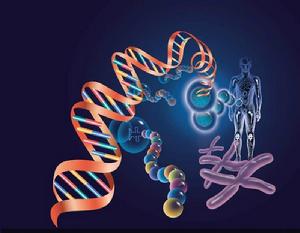 一项加拿大研究显示,1种常见基因与若干罕见的生殖器官癌症有关,这项发现可望有助发展新的治疗方法。《新英格兰医学期刊》(New England Journal of Medicine)刊登的这项研究指出,卵巢癌、子宫癌和睾丸癌1种名为DICER的基因,都出现相同突变。
一项加拿大研究显示,1种常见基因与若干罕见的生殖器官癌症有关,这项发现可望有助发展新的治疗方法。《新英格兰医学期刊》(New England Journal of Medicine)刊登的这项研究指出,卵巢癌、子宫癌和睾丸癌1种名为DICER的基因,都出现相同突变。
科学家已知基因DICER的存在多年,但却不清楚它对于刺激癌细胞生长的确切作用。
研究共同撰写人、卑诗省癌症中心(British Columbia Cancer Agency)的麦可史密斯基因组科学中心(Michael Smith Genome Sciences Centre)的权威科学家毛林(Gregg Morin)表示,基因DICER突变时,功能会转变,“使它能直接参与癌症初始的生成”。
毛林解释道:“DICER好比是部分身体功能的指挥,而这些功能对于正常细胞的生长与作用而言极为关键。我们发现到的突变不会完全破坏DICER的功能,而是使其变形。“
研究人员正检验DICER基因是否会对其他癌症造成影响,并将研究突变后的基因能否运用在其诱发的癌症治疗。

 Recurrent Somatic DICER1 Mutations in Nonepithelial Ovarian Cancers
Recurrent Somatic DICER1 Mutations in Nonepithelial Ovarian Cancers
Alireza Heravi-Moussavi, Ph.D., Michael S. Anglesio, Ph.D., S.-W. Grace Cheng, Ph.D., Janine Senz, B.Sc., Winnie Yang, B.Sc., Leah Prentice, Ph.D., Anthony P. Fejes, M.Sc., Christine Chow, B.M.L.Sc., Alicia Tone, Ph.D., Steve E. Kalloger, B.Sc., Nancy Hamel, M.Sc., Andrew Roth, B.Sc., Gavin Ha, B.Sc., Adrian N.C. Wan, B.Sc., Sarah Maines-Bandiera, M.Sc., Clara Salamanca, B.Sc., Barbara Pasini, M.D., Blaise A. Clarke, M.D., Anna F. Lee, M.D., Ph.D., Cheng-Han Lee, M.D., Ph.D., Chengquan Zhao, M.D., Robert H. Young, M.D., Samuel A. Aparicio, B.M., B.Ch., Ph.D., Poul H.B. Sorensen, M.D., Ph.D., Michelle M.M. Woo, Ph.D., Niki Boyd, Ph.D., Steven J.M. Jones, Ph.D., Martin Hirst, Ph.D., Marco A. Marra, Ph.D., Blake Gilks, M.D., Sohrab P. Shah, Ph.D., William D. Foulkes, M.B., B.S., Ph.D., Gregg B. Morin, Ph.D., and David G. Huntsman, M.D.
BACKGROUND Germline truncating mutations in DICER1, an endoribonuclease in the RNase III family that is essential for processing microRNAs, have been observed in families with the pleuropulmonary blastoma–family tumor and dysplasia syndrome. Mutation carriers are at risk for nonepithelial ovarian tumors, notably sex cord–stromal tumors.
METHODS We sequenced the whole transcriptomes or exomes of 14 nonepithelial ovarian tumors and noted closely clustered mutations in the region of DICER1 encoding the RNase IIIb domain of DICER1 in four samples. We then sequenced this region of DICER1 in additional ovarian tumors and in certain other tumors and queried the effect of the mutations on the enzymatic activity of DICER1 using in vitro RNA cleavage assays.
RESULTS DICER1 mutations in the RNase IIIb domain were found in 30 of 102 nonepithelial ovarian tumors (29%), predominantly in Sertoli–Leydig cell tumors (26 of 43, or 60%), including 4 tumors with additional germline DICER1 mutations. These mutations were restricted to codons encoding metal-binding sites within the RNase IIIb catalytic centers, which are critical for microRNA interaction and cleavage, and were somatic in all 16 samples in which germline DNA was available for testing. We also detected mutations in 1 of 14 nonseminomatous testicular germ-cell tumors, in 2 of 5 embryonal rhabdomyosarcomas, and in 1 of 266 epithelial ovarian and endometrial carcinomas. The mutant DICER1 proteins had reduced RNase IIIb activity but retained RNase IIIa activity.
CONCLUSIONS Somatic missense mutations affecting the RNase IIIb domain of DICER1 are common in nonepithelial ovarian tumors. These mutations do not obliterate DICER1 function but alter it in specific cell types, a novel mechanism through which perturbation of microRNA processing may be oncogenic. (Funded by the Terry Fox Research Institute and others.)
文献链接:https://www.nejm.org/doi/full/10.1056/NEJMoa1102903#t=articleTop







